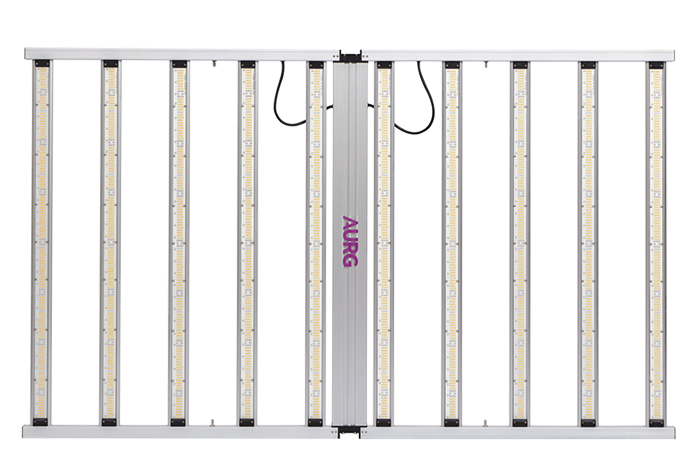What Color Light Is Best for Plant Growth
Light is the most important factor influencing how plants grow, bloom, and bear fruit. Every plant needs light to photosynthesize, but not all light colors are equally effective. The specific wavelengths—or colors—of light that plants absorb directly affect their development, shape, and productivity.
With the rise of LED plant grow lights, growers can now fine-tune the light spectrum to provide exactly what plants need. Companies like AURG, with their advanced grow light systems, use precise color engineering to optimize each growth stage, ensuring maximum yield and energy efficiency.
Let’s explore which light colors are best for plant growth and how modern LED lighting technology helps you use them effectively.

1. Understanding the Light Spectrum for Plants
Sunlight appears white to the human eye but is actually composed of a full spectrum of colors—red, blue, green, yellow, and others. Plants absorb specific wavelengths for photosynthesis, mainly within the Photosynthetically Active Radiation (PAR) range, which spans 400–700 nanometers (nm).
| Color | Wavelength (nm) | Plant Function | Importance Level |
|---|---|---|---|
| Blue | 400–500 | Encourages strong roots, stems, and leaves | ⭐⭐⭐⭐ |
| Red | 600–700 | Stimulates flowering and fruiting | ⭐⭐⭐⭐⭐ |
| Green | 500–570 | Penetrates deeper into foliage for balanced growth | ⭐⭐ |
| Far-Red | 700–750 | Affects plant height and flowering signals | ⭐⭐⭐ |
| UV & IR | <400 / >750 | Supports protection and blooming triggers (limited use) | ⭐⭐ |
Different wavelengths have distinct biological effects. For ideal results, a combination of these colors is required to simulate natural sunlight—but optimized for plant response.
2. The Role of Blue and Red Light in Growth
2.1 Blue Light: The Foundation for Vegetative Growth
Blue light (around 450 nm) is crucial during the early stages of plant development. It influences chlorophyll production, helping seedlings grow strong and compact instead of tall and weak.
When plants receive enough blue light:
They develop thicker leaves and stronger stems.
They maintain compact growth with less stretching.
Photosynthesis becomes more efficient, improving nutrient absorption.
AURG’s LED systems incorporate high-efficiency blue diodes to ensure seedlings receive the perfect start in hydroponic and indoor environments.
2.2 Red Light: The Key to Flowering and Fruiting
Red light (around 660 nm) drives photosynthesis and reproductive growth. It helps plants transition from the vegetative stage to the flowering or fruiting stage.
Benefits of red light:
Promotes bud formation and blooming.
Increases fruit size, flavor, and density.
Works synergistically with blue light for balanced growth.
AURG’s grow lights combine deep red and far-red wavelengths, ensuring full control over the flowering cycle and yield quality.
3. Other Important Colors for Plant Development
While red and blue dominate plant lighting discussions, other colors contribute in subtle but valuable ways.
| Color | Function | AURG Advantage |
|---|---|---|
| Green Light (500–570 nm) | Penetrates the upper leaf layers to reach lower foliage, improving uniform photosynthesis. | Balanced spectral mix in AURG systems ensures all canopy levels receive adequate illumination. |
| Far-Red (700–750 nm) | Extends flowering and affects stem elongation through the “shade avoidance” effect. | AURG integrates adjustable far-red channels to fine-tune plant morphology. |
| UV Light (<400 nm) | Triggers protective compounds (flavonoids) that improve plant color and taste. | Controlled UV output available in premium AURG grow lights for specialty crops. |
| Infrared (>750 nm) | Regulates plant temperature perception and accelerates bloom initiation. | Infrared diodes add warmth and enhance overall light efficiency. |
Each of these colors helps create a full-spectrum environment where plants can thrive at every stage.
4. The Ideal Light Color Combination for Each Growth Stage
Every stage of plant development benefits from a different color ratio. Using full-spectrum LED grow lights like those from AURG allows growers to simulate natural sunlight and adjust color dominance according to the growth phase.
| Growth Stage | Ideal Spectrum Ratio | Primary Color Focus | AURG Technology Support |
|---|---|---|---|
| Seedling Stage | 70% Blue / 30% Red | Blue | High blue intensity promotes root and leaf foundation. |
| Vegetative Stage | 50% Blue / 50% Red | Balanced | Even growth and dense canopy with balanced PAR spectrum. |
| Flowering/Fruiting Stage | 30% Blue / 70% Red | Red | Red-heavy light encourages blooms and fruit production. |
| Late Flowering | 20% Blue / 80% Red + Far-Red | Deep Red | Far-red triggers hormonal changes for higher yield. |
AURG’s Adaptive Spectrum Control technology lets users customize this ratio easily, ensuring perfect alignment with plant biology.
5. Benefits of Using AURG Full-Spectrum LED Grow Lights
AURG’s LED grow light systems are engineered to deliver precisely calibrated light colors that mimic and enhance the natural sunlight spectrum. Unlike conventional lighting, AURG LEDs allow you to adjust color ratios for maximum growth efficiency.
Key Benefits:
Customizable Spectrum: Adjust red, blue, and far-red intensities based on crop type.
Uniform Light Distribution: Even coverage eliminates shadow zones on dense canopies.
Energy Efficiency: Converts most energy into usable light, reducing power costs by up to 70%.
Durable and Safe: Built with aluminum heat sinks and certified for long-term stability in demanding environments.
Scientifically Validated Results: Developed in collaboration with horticultural researchers to enhance photosynthesis and plant yield.
By blending technology and biology, AURG’s lighting solutions provide plants with the exact color recipe they need for faster growth and superior harvest quality.
6. Practical Tips for Using Colored Lights in Plant Growth
Use full-spectrum lights instead of single-color LEDs to cover all stages efficiently.
Avoid excessive blue light during flowering; it can limit bloom size.
Provide at least 12–16 hours of light daily for most indoor plants.
Maintain distance between the lights and plants (usually 30–50 cm for LEDs) to prevent light stress.
Monitor temperature; even LEDs generate some heat, so adequate ventilation is essential.
AURG’s grow lights include intelligent dimming and timing controls, allowing easy management of intensity and duration to suit any plant species.
7. Summary: The Best Light Colors for Plant Growth
| Light Color | Growth Function | Best Used For |
|---|---|---|
| Blue (450 nm) | Builds strong stems, leaves, and roots | Seedling and vegetative stages |
| Red (660 nm) | Boosts flowering and fruiting | Flowering and fruiting stages |
| Far-Red (730 nm) | Enhances bloom and fruit ripening | Late flowering |
| Green (520 nm) | Balances canopy lighting | All stages |
| Full Spectrum (400–700 nm) | Supports all growth phases | Complete plant cycle |
In essence, a balanced combination of red and blue light—enhanced with green and far-red wavelengths—delivers the best results for overall plant health and productivity.
Conclusion
The best light color for plant growth depends on the plant’s stage and your growing objectives. Blue light drives vegetative growth, red light triggers flowering, and a balanced full-spectrum blend ensures complete development.
AURG’s full-spectrum LED grow lights integrate all these wavelengths into a scientifically tuned design, enabling growers to simulate natural sunlight and achieve exceptional results—whether cultivating leafy greens, herbs, or flowering crops.
To unlock optimal growth and yield, explore AURG LED Plant Grow Lights — where advanced spectrum control meets the science of photosynthesis.
Previous: Do LED Lights Grow Plants?



